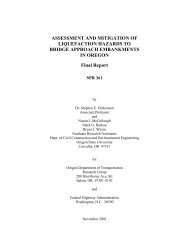Oregon Balance of State HIV/AIDS Housing & Services Systems ...
Oregon Balance of State HIV/AIDS Housing & Services Systems ...
Oregon Balance of State HIV/AIDS Housing & Services Systems ...
You also want an ePaper? Increase the reach of your titles
YUMPU automatically turns print PDFs into web optimized ePapers that Google loves.
<strong>Oregon</strong> <strong>HIV</strong>/<strong>AIDS</strong> <strong>Housing</strong> and <strong>Services</strong> <strong>Systems</strong> Integration Plan 17<br />
Integration <strong>of</strong> <strong>HIV</strong>/<strong>AIDS</strong> <strong>Services</strong> and <strong>Housing</strong> with<br />
Existing <strong>Systems</strong><br />
This section describes how <strong>HIV</strong>/<strong>AIDS</strong> services and housing are currently integrated into other<br />
systems in the balance <strong>of</strong> state and identifies opportunities that exist for further integration with<br />
existing or potential partners.<br />
Meaningful integration with mainstream housing and service providers and the general public is<br />
critical for <strong>Oregon</strong> <strong>Housing</strong> Opportunities in Partnership (OHOP) and other programs and agencies<br />
that serve people living with <strong>HIV</strong>/<strong>AIDS</strong> in <strong>Oregon</strong>. Connections to local service providers and<br />
housing agencies help ensure that OHOP resources are reaching all <strong>of</strong> the diverse communities <strong>of</strong><br />
eligible clients in need, and assure that the needs <strong>of</strong> people with multiple, co-occurring challenges<br />
are recognized and efficiently addressed. In addition, partnership with mainstream housing<br />
organizations (such as affordable housing developers or housing authorities) and participation in<br />
planning processes (such as the Continuum <strong>of</strong> Care or Consolidated Funding Cycle processes) can<br />
lead to the development or dedication <strong>of</strong> new housing resources, targeted either for people with<br />
disabilities in general or specifically for people living with <strong>HIV</strong>/<strong>AIDS</strong>.<br />
The first part <strong>of</strong> this chapter presents information on general outreach strategies that OHOP and its<br />
partners use or could use to communicate with an array <strong>of</strong> different systems, as well as outlines<br />
some barriers to transparent and effective communication. The second part <strong>of</strong> the chapter provides<br />
context information on some <strong>of</strong> the most relevant systems, including key components <strong>of</strong> the<br />
particular system, the level <strong>of</strong> integration that exists with <strong>HIV</strong>/<strong>AIDS</strong> housing and services, and<br />
challenges within that system. This “map” <strong>of</strong> interlocking systems is intended to help OHOP and its<br />
partners better understand how to employ dedicated <strong>HIV</strong>/<strong>AIDS</strong> resources to complement existing<br />
capacity in these regions, and how to most effectively collaborate with the broader set <strong>of</strong> affordable<br />
housing and services systems to increase and maintain capacity to serve as many <strong>Oregon</strong>ians as<br />
possible. (Critical issues within this context, and specific recommendations for addressing<br />
challenges and meeting need among people living with <strong>HIV</strong>/<strong>AIDS</strong>, are addressed in the subsequent<br />
section (Section 2), beginning on page 40 <strong>of</strong> this plan.)<br />
Information for these sections comes from primary research, interviews with key informants across<br />
the state, and a survey <strong>of</strong> stakeholders. The stakeholders that participated in the survey were divided<br />
between the four OHOP service regions. Half <strong>of</strong> the respondents represent <strong>HIV</strong>/<strong>AIDS</strong> agencies, and<br />
half represent agencies that do not specifically provide services to people with <strong>HIV</strong>/<strong>AIDS</strong>, although<br />
some <strong>of</strong> their clients may have an <strong>HIV</strong> diagnosis. Detailed survey responses are also available in<br />
Appendix 2.<br />
Outreach Strategies<br />
Outreach to a broad spectrum <strong>of</strong> housing and service system stakeholders and others must be the<br />
cornerstone <strong>of</strong> any integration effort. Because the number <strong>of</strong> <strong>Oregon</strong> residents living with<br />
<strong>HIV</strong>/<strong>AIDS</strong> outside <strong>of</strong> the Portland metro area is relatively small and spread out, OHOP and partner<br />
staff must take a proactive role simply to make known the needs <strong>of</strong> this population and the

















